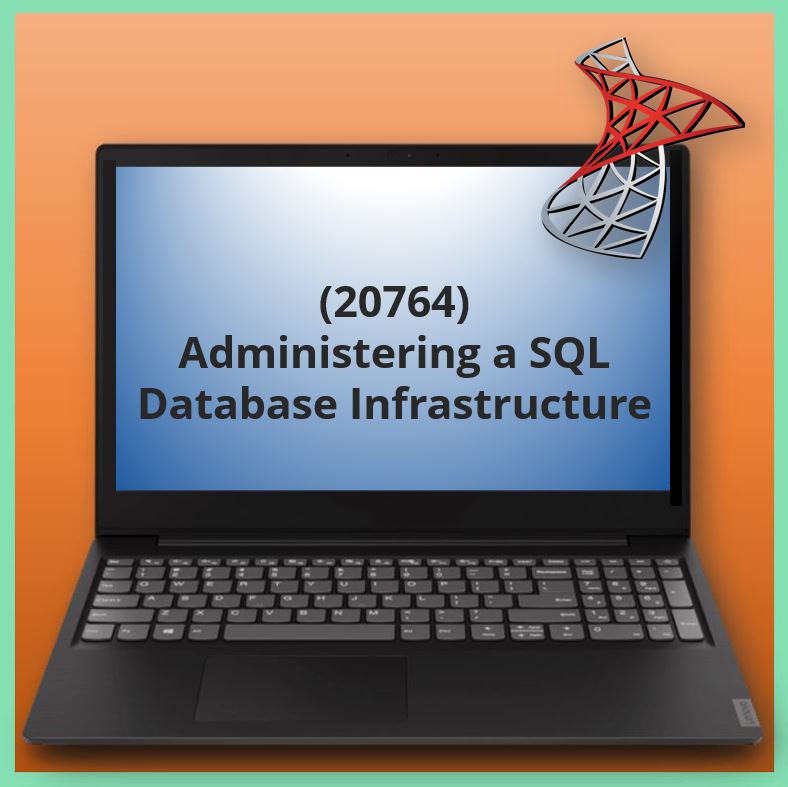Aangeboden leervormen
Administering a SQL Database Infrastructure (20764)
Course Description
This course provides students who administer and maintain SQL Server databases with the knowledge and skills to administer a SQL server database infrastructure. Additional it will be of use to individuals who develop applications that deliver content from SQL Server databases.
At Course Completion
After completing this course, students will be able to:
• Authenticate and authorize users
• Assign server and database roles
• Authorize users to access resources
• Protect data with encryption and auditing
• Describe recovery models and backup strategies
• Backup SQL Server databases
• Restore SQL Server databases
• Automate database management
• Configure security for the SQL Server agent
• Manage alerts and notifications
• Managing SQL Server using PowerShell
• Trace access to SQL Server
• Monitor a SQL Server infrastructure
• Troubleshoot a SQL Server infrastructure
• Import and export data

Voor wie
The primary audience for this course is individuals who administer and maintain SQL Server databases. These individuals perform database administration and maintenance as their primary area of responsibility, or work in environments where databases play a key role in their primary job.
The secondary audiences for this course are individuals who develop applications that deliver content from SQL Server databases.
Programma
Voor het programma van E-Learning >>>KLIK HIER<<<
Module 1: Authenticating and Authorizing Users
This module covers SQL Server security models, logins, and users.
Lessons
• Authenticating connections to SQL Server
• Authorizing logins to access databases
• Authorization across servers
• Partially contained databases
Lab : Authenticating Users
After completing this module, you will be able to:
• Describe server level security
• Describe database level security
• Describe multi-server authentication
• Describe partially contained databases
Module 2: Assigning Server and Database Roles
This module covers fixed server roles, user-defined server roles, fixed database roles, and user-defined database roles.
Lessons
• Working with server roles
• Working with Fixed database roles
• Creating user-defined database roles
Lab : Assigning server and database roles
After completing this module, you will be able to:
• Describe server roles
• Describe fixed database roles
• Describe user-defined database roles
Module 3: Authorizing Users to Access Resources
This module covers permissions and the assignment of permissions.
Lessons
• Authorizing user access to objects
• Authorizing users to execute code
• Configuring permissions at the schema level
Lab : Authorizing users to access resources
After completing this module, you will be able to:
• Describe how to authorize user access to objects
• Describe how to authorize users to execute code
• Describe how to configure permissions at the schema level
Module 4: Protecting Data with Encryption and Auditing
This module covers SQL Server Audit.
Lessons
• Options for auditing data access in SQL Server
• Implementing SQL Server audit
• Managing SQL Server audit
• Protecting data with encryption
Lab : Using Auditing and Encryption
After completing this module, you will be able to:
• Describe options for auditing data access.
• Implement SQL Server Audit.
• Manage SQL Server Audit.
• Describe how to use custom audit events.
• Implement encryption
Module 5: SQL Server Recovery Models
This module describes the concept of the transaction log and SQL Server recovery models. It also introduces the different backup strategies available with SQL Server.
Lessons
• Backup strategies
• Understanding SQL Server transaction login
• Planning a SQL Server backup strategy
Lab : Understanding SQL Server recovery models
After completing this module, you will be able to:
• Describe the various backup strategies.
• Describe how database transaction logs function.
• Plan a SQL Server backup strategy.
Module 6: Backup of SQL Server Databases
This module describes SQL Server Backup and the backup types
Lessons
• Backing up databases and transaction logs
• Managing database backups
• Working with backup options
Lab : Backing up SQL Server databases
After completing this module, you will be able to:
• Perform backups of SQL Server databases and transaction logs.
• Manage database backups.
• Describe the advanced backup options.
• Describe how to backup to the Azure Windows Blob Store.
Module 7: Restoring SQL Server Databases
This module describes the restoration of databases.
Lessons
• Understanding the restore process
• Restoring databases
• Working with point-in-time recovery
• Restoring system databases and individual files
Lab : Restoring SQL Server User Databases
After completing this module, you will be able to:
• Explain the database restore process.
• Describe the concept of point in time recovery.
• Describe the advanced concepts of restoring.
Module 8: Automating SQL Server Management
This module describes how to use SQL Server Agent for automation. It also explains the benefits of using master and target servers to centralize the administration of automation.
Lessons
• Automating SQL Server management
• Working with SQL Server agent
• Managing SQL Server agent jobs
• Multi-server management
Lab : Automating SQL Server Management
After completing this module, you will be able to:
• Describe methods for automating SQL Server Management.
• Configure jobs, job step types, and schedules.
• Manage SQL Server Agent jobs.
• Configure master and target servers.
Module 9: Configuring Security for SQL Server Agent
This module describes the considerations for SQL Server Agent security, including proxy accounts and credentials.
Lessons
• Understanding SQL Server Agent Security
• Configuring credentials
• Configuring proxy accounts
Lab : Configuring Security for SQL Server Agent
After completing this module, you will be able to:
• Describe the security context for SQL Server Agent jobs.
• Configure credentials.
• Configure proxy accounts.
Module 10: Monitoring SQL Server with Alerts and Notifications
This module covers the configuration of database mail, alerts and notifications.
Lessons
• Configuration of database mail
• Monitoring SQL Server errors
• Configuring operators, alerts, and notifications
• Alerts in Azure SQL database
Lab : Monitoring SQL Server with Alerts and Notifications
After completing this module, you will be able to:
• Configure database mail.
• Monitor SQL Server errors.
• Configure operators, alerts and notifications.
Module 11: Introduction to Managing SQL Server by using PowerShell
This module introduces PowerShell for SQL Server.
Lessons
• Configure SQL Server using PowerShell
• Administer SQL Server using PowerShell
• Maintain the SQL Server environment using PowerShell
• Managing Azure SQL Server databases using PowerShell
Lab : Administering SQL Server using PowerShell
After completing this module, you will be able to:
• Configure SQL Server using PowerShell
• Manage day-to-day SQL Server Administration with PowerShell
• Maintain the SQL Server environment using PowerShell.
Module 12: Tracing Access to SQL Server
This module describes how to use SQL Profiler and SQL Trace stored procedures to capture information about SQL Server. The module also describes how to use Distributed Replay to capture trace information from multiple servers, and how to monitor locking.
Lessons
• Capturing activity using SQL Server profiler
• Improving performance with the database engine tuning advisor
• Working with tracing options
• Distributed replay
• Monitoring locks
Lab : Tracing Access to SQL Server
After completing this module, you will be able to:
• Configure SQL Profiler traces and review captured traces.
• Use the Database Engine Tuning Advisor.
• Understand SQL Server advanced tracing concepts.
• Use Distributed Replay.
• Monitor Locking.
Module 13: Monitoring SQL Server
This module explains how to use Distributed Management Views to monitor SQL Server. It also describes configuration of data collection and the SQL Server Utility.
Lessons
• Monitoring activity
• Capturing and managing performance data
• Analyzing collected performance data
• SQL Server utility
Lab : Monitoring SQL Server
After completing this module, you will be able to:
• Monitor activity within SQL Server
• Configure data collection.
• View reports from data collection.
• Configure a SQL Server Utility (UCP)
Module 14: Troubleshooting SQL Server
This module explains the SQL Server troubleshooting methodology and discusses the most common issues that can arise when working with SQL Server systems.
Lessons
• SQL Server troubleshooting methodology
• Resolving service related issues
• Resolving login and connectivity issues
• Troubleshooting common issues
Lab : Troubleshooting Common Issues
After completing this module, you will be able to:
• Explain the SQL Server troubleshooting methodology.
• Resolve service-related issues.
• Resolve login and connectivity issues
Module 15: Importing and Exporting Data
This module covers the use of the import/export wizards and explains how they relate to SSIS. The module also introduces BCP and BULK INSERT.
Lessons
• Transferring data to/from SQL Server
• Importing and exporting table data
• Using BCP and BULK INSERT to import data
• Deploying and upgrading data-tier applications
Lab : Importing and Exporting Data
After completing this module, you will be able to:
• Transfer data.
• Import and export table data.
• Use BCP and BULK INSERT to import data.
• Use DACs to import and export database applications
Voorkennis
In addition to their professional experience, students who attend this training should already have the following technical knowledge:
· Basic knowledge of the Microsoft Windows operating system and its core functionality.
· Working knowledge of Transact-SQL.
· Working knowledge of relational databases.
· Some experience with database design.
Examen
Microsoft Exam 70-764
Duur training
Klassikaal: 4 dagen
Open leercentrum: 5 dagen
Blended Learning: 3 dagen
E-Learning: 90 dagen











